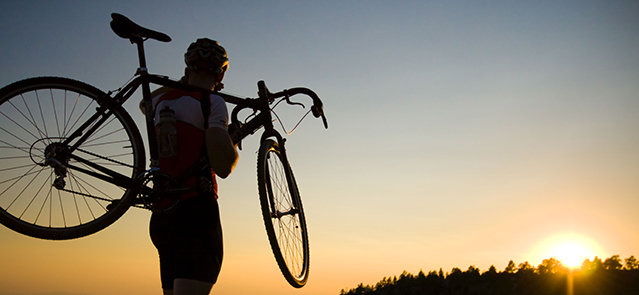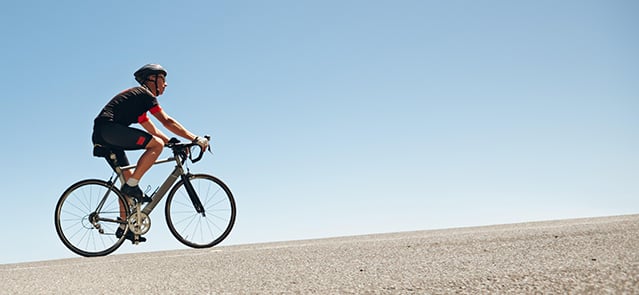A guide to light bikes
October 31, 2016
Do you want a bike so pared back that it almost needs tethering in the wind? Richard Peace looks at the pros and cons of light bikes to see whether the benefits stack up.

Photo: Alamy
Bike manufacturers are going pedal-to-pedal to produce the world’s lightest bike. Frame weights have dropped below 700g, which is less than a shop brand cottage pie for two (if you’re looking for a comparison), with complete bike weights moving down towards 4kg on some specialist models – about the same weight as a large bag of gourmet cat biscuits. But how important is the pursuit of the lightest bike if you’re looking to improve your performance?
Weighty matters
Bike weight is undoubtedly an important factor, especially for hill-climbing performance cyclists, for whom every fraction of a second counts. Put simply, cycling uphill means working against gravity, so the less weight you have to get up the hill (all other factors like power rider output, wind and rider weight being equal) the quicker you will be.
Bike weights in the world of racing have come down and down over the years, so much so that the sport’s governing body, the UCI, has set a weight minimum limit of 6.8kg.
Lennard Zinn, a world-renowned bicycle technician, frame builder and tech writer for VELO magazine and VeloNews.com, gives a real-world example to show the importance of weight: ‘Adding about 1.8kg to a bike and riding up a big climb, namely Alpe d’Huez… added to the rider’s time. It made him about 2% slower.’
In a more extreme example quoted by Zinn, comparing a heavy touring bike with a racer, ‘a 20lb (9kg) weight difference in bikes yielded a 13.6% drop in speed’.
According to Zinn, the lighter bike will climb faster with the same amount of power from the rider. Of course, the question then becomes whether that extra speed matters enough for you to spend the big money.
While relatively big drops in weight result in big increases in speed, marginal drops in weight (often coming at great expense) will only bring marginal benefits for riders. However, it may still be important to those competing at the top, where they will have tried to maximise the advantages from other factors too.
James C Martin, PhD, is assistant professor in the department of exercise and sport science at the University of Utah. He calculated the effect of smaller weight gains for riding up a grade of hill similar to the famed alpine Stelvio Pass (the second highest paved pass in the Alps) and came up with a figure of six seconds added for each extra pound (about 0.45kg).
Of course, there are other advantages to much lighter bikes; they are more thrilling to ride as they both climb and accelerate quicker than heavier bikes and if you regularly ride very long and steep hills weight loss will be an even greater boon.
Show me the lightest
So what options are there for light bikes? The following are based on my research and the figures given here may end being trumped as bike brands release more detail about their 2017 bike lines. However, the details do give a good indication of what are very light bikes in their respective designs.
Road bike: Super-light specialist Merida claimed the ‘world’s lightest production bike’ tag for 2016 with its 4.5kg Scultura 9000 LTD model. It has a carbon frame thickness of 0.4mm in places. Check out the story of Gunter Mai and Fairwheel Bikes, who managed to produce a 2.7kg bike between them, thought to be the lightest bike of all time. Just in case you are wondering, there is also a world record for the heaviest rideable bike.
Mountain bike: While there doesn’t seem to be a widely acknowledged record for a lightweight mountain bike, anything under 10kg is pretty special. The Scott Spark 2017 range looks to be setting new standards in the area of full-suspension bikes. For fans of fat tyre bikes, the UK’s own Shand Oykel comes in at about 9.5kg.
Folding bike: It’s especially important for folding bikes to be compact and light for carrying and lifting when folded. There are not that many folding bikes under 10kg, but the 6.7kg Hummingbird claims to be the lightest in this class.
Electric Bike: Budnitz believes it has produced the world’s lightest standard configuration electric bike at 13kg. Under 20kg is good and anything under 15kg is hugely impressive, but there’s certainly a very strong case to say that weight (or lack of it) isn’t everything in gaining speed.
All the angles
While your bike can’t regulate its diet, you can. Jim Gourley, a triathlete with an aerospace engineering degree from the US Air Force Academy, tackles this topic in his book Faster: Demystifying the Science of Triathlon Speed.
The focus should be on total weight, and not tiny losses in bike weight, says Gourley. ‘A lot of equipment manufacturers will tell you that their handlebars are 20g lighter than their competitor’s. But you need to be measuring differences in pounds to make any kind of noticeable change. A difference of 20g matters to NASA getting to the moon, but it’s not going to make a lick of difference to you trying to make a breakaway.’
If you regularly ride long and steep hills, a lighter bike will help. Photo: Alamy
The UK’s Merlin has an enviable reputation for handbuilt wheels and has been speccing top-class road bikes for many years. It also has a great blog. The company has listed many other factors to consider before you start splashing out huge amounts of cash to save just a few grammes.
Tyres & brakes: Get your tyres wrong and it doesn’t matter how light your bike is – it’s going to handle like a pig. Bad brakes can lead to tiring, scary, unenjoyable and frustrating rides.
Aerodynamics: Making a £1,000 bike more aerodynamic will be more rewarding than making a £1,000 bike lighter. For the advantages of a top-of-the-range aero bike at higher speeds, see Cycling Weekly’s review of the Trek Madone 9.9.
Riding in a group: Working in a group – even a small group – and taking it in turns to draft each other can save you about 20% effort.
Skills: Practice, practice, practice will always trump spend, spend, spend.
Body weight: Oxygen uptake into the blood improves significantly as fat is lost. As well as having less mass to haul around, skinnier cyclists also benefit from having bodies that cope better with exercise.
So is light always right?
While it might be a bit more fun to ride, don’t expect a lighter bike to suddenly move you into the fast lane and allow you to race up that stubborn hill.
Merlin’s Rick Robson says that super lightweight bikes suit those with a mixture of highly trained, light rider body and good riding ability, who will find very light bikes less jarring and more comfortable.
‘When a very light bike has 85kg on it as opposed to 60kg, there is a fair amount of extra stress to be absorbed by the frame, when riders make sudden efforts or hit drains or potholes. Spending around £1,500 will get you a light, stiff and comfortable bike probably weighing about 7.5kg to 8kg. Spending around £2,000 could get a lighter bike at 7kg to 7.5kg. At the other end of the spectrum, a £1,000 bike would weigh in at around 8.5kg.’
Richard Peace is a regular contributor to Cyclists’ Touring Club magazine and Cycle magazine
Find out more about Hiscox Bicycle cover as part of Hiscox Home Insurance.







 Very satisfied with the service from Hiscox as always
Very satisfied with the service from Hiscox as always

